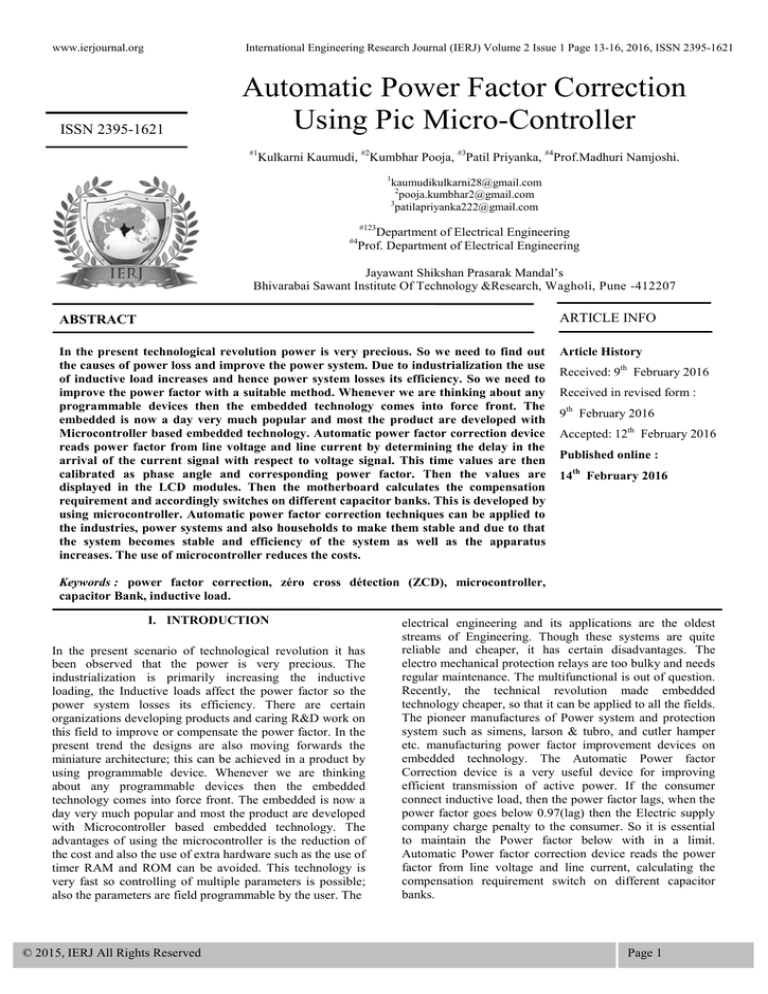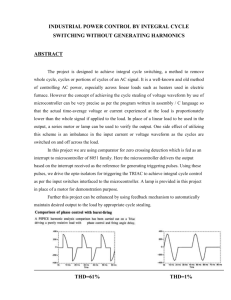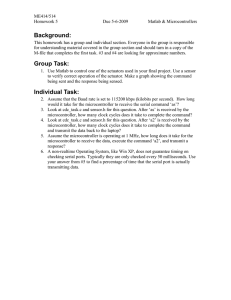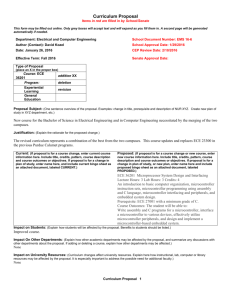
www.ierjournal.org
International Engineering Research Journal (IERJ) Volume 2 Issue 1 Page 13-16, 2016, ISSN 2395-1621
ISSN 2395-1621
Automatic Power Factor Correction
Using Pic Micro-Controller
#1
Kulkarni Kaumudi, #2Kumbhar Pooja, #3Patil Priyanka, #4Prof.Madhuri Namjoshi.
1
kaumudikulkarni28@gmail.com
2
pooja.kumbhar2@gmail.com
3
patilapriyanka222@gmail.com
#123
Department of Electrical Engineering
Prof. Department of Electrical Engineering
#4
Jayawant Shikshan Prasarak Mandal’s
Bhivarabai Sawant Institute Of Technology &Research, Wagholi, Pune -412207
ABSTRACT
ARTICLE INFO
In the present technological revolution power is very precious. So we need to find out
the causes of power loss and improve the power system. Due to industrialization the use
of inductive load increases and hence power system losses its efficiency. So we need to
improve the power factor with a suitable method. Whenever we are thinking about any
programmable devices then the embedded technology comes into force front. The
embedded is now a day very much popular and most the product are developed with
Microcontroller based embedded technology. Automatic power factor correction device
reads power factor from line voltage and line current by determining the delay in the
arrival of the current signal with respect to voltage signal. This time values are then
calibrated as phase angle and corresponding power factor. Then the values are
displayed in the LCD modules. Then the motherboard calculates the compensation
requirement and accordingly switches on different capacitor banks. This is developed by
using microcontroller. Automatic power factor correction techniques can be applied to
the industries, power systems and also households to make them stable and due to that
the system becomes stable and efficiency of the system as well as the apparatus
increases. The use of microcontroller reduces the costs.
Article History
Received: 9th February 2016
Received in revised form :
9th February 2016
Accepted: 12th February 2016
Published online :
14th February 2016
Keywords : power factor correction, zéro cross détection (ZCD), microcontroller,
capacitor Bank, inductive load.
I. INTRODUCTION
In the present scenario of technological revolution it has
been observed that the power is very precious. The
industrialization is primarily increasing the inductive
loading, the Inductive loads affect the power factor so the
power system losses its efficiency. There are certain
organizations developing products and caring R&D work on
this field to improve or compensate the power factor. In the
present trend the designs are also moving forwards the
miniature architecture; this can be achieved in a product by
using programmable device. Whenever we are thinking
about any programmable devices then the embedded
technology comes into force front. The embedded is now a
day very much popular and most the product are developed
with Microcontroller based embedded technology. The
advantages of using the microcontroller is the reduction of
the cost and also the use of extra hardware such as the use of
timer RAM and ROM can be avoided. This technology is
very fast so controlling of multiple parameters is possible;
also the parameters are field programmable by the user. The
© 2015, IERJ All Rights Reserved
electrical engineering and its applications are the oldest
streams of Engineering. Though these systems are quite
reliable and cheaper, it has certain disadvantages. The
electro mechanical protection relays are too bulky and needs
regular maintenance. The multifunctional is out of question.
Recently, the technical revolution made embedded
technology cheaper, so that it can be applied to all the fields.
The pioneer manufactures of Power system and protection
system such as simens, larson & tubro, and cutler hamper
etc. manufacturing power factor improvement devices on
embedded technology. The Automatic Power factor
Correction device is a very useful device for improving
efficient transmission of active power. If the consumer
connect inductive load, then the power factor lags, when the
power factor goes below 0.97(lag) then the Electric supply
company charge penalty to the consumer. So it is essential
to maintain the Power factor below with in a limit.
Automatic Power factor correction device reads the power
factor from line voltage and line current, calculating the
compensation requirement switch on different capacitor
banks.
Page 1
www.ierjournal.org
International Engineering Research Journal (IERJ) Volume 2 Issue 1 Page 13-16, 2016, ISSN 2395-1621
II. PROPOSED SYSTEM
Fig 1. Block Diagram of APFC
Microcontroller base automatic controlling of power factor
with load monitoring is shown in above figure. The
principal element in the circuit is PIC Microcontroller that
manipulates with 8 MHz crystal in this scheme. The current
and voltage signal are coming from the main AC supply by
using Current Transformer and Potential Transformer.
These acquired signals are then pass on to the zero crossing
detector IC(ZCD I & ZCD V) individually that transposed
both current and voltage waveforms to square-wave to make
perceivable to the Microcontroller to observe the zero
crossing of current and voltage at the same time instant.
Microcontroller read the RMS value for voltage and current
used in its algorithm to select the value of capacitor for the
load to correct the power factor and monitors the behavior
of the load on the basis of current depleted by the load.
Synchronizing circuit is developed to synchronize the zero
cross detection circuit, Microcontroller and LCD with
incoming supply voltage. In case of low power factor
Microcontroller send out the signal to switching unit (relay).
Then relay will operate and it adds the capacitor bank in
circuit. The tasks executed by the Microcontroller for
correcting the low power factor by selecting the capacitor
and load monitoring are shown in Liquid Crystal Display
(LCD).
III. CALCULATION
Vrms and Irms are read by the Microcontroller
using ADC ports.
After the zero crossing of voltage and current
signals, which are converted to square-waves, are
provided to Microcontroller.
Power Factor is measured by the Microcontroller
from manipulating of capture module for V and I
signals.
Real Power is measure as
P= Irms Vrms cosφ
For angle detection by taking the cos inverse of
phi(φ) and getting the angle theta (𝜃).
Set the Phi (φ2) as a reference value equal
to1.00.and taking the cos inverse of 1.00 getting
reference theta (𝜃1).
From the power angle diagram, the reactive power
(VAR) utilized in circuit is given as:
VAR1= P × tan θ
© 2015, IERJ All Rights Reserved
(1)
For reference VAR
VAR2= P × tan θ1
Page 2
(2)
(3)
www.ierjournal.org
International Engineering Research Journal (IERJ) Volume 2 Issue 1 Page 13-16, 2016, ISSN 2395-1621
V. HARDWARE AND RESULT DISCUSSION
Required reactive power of the load is:
VAR= VAR1- VAR2
(4)
Current required for new VAR by load is:
I required= VAR / Vrms
(5)
Required value of impedance Xc is:
XC = Vrms / I required
(6)
Required capacitor to improve the power factor for
Inductive load is given as:
C = 1 / 2π f Xc
(7)
IV. FLOW CHART
Fig 3 Hardware model with inductive load
Above fig 3 shows the complete hardware model with
inductive load. Voltage and current signal are coming from
main AC supply (230v, single phase) by using potential
transformer (PT) and current transformer (CT),these are
used as sensors. It senses voltage and current and then it is
given to the comparator. In comparator ZCD(I) and ZCD(V)
individually transposes both current and voltage waveform
to square wave to make perceivable to microcontroller to
observe the current and voltage at same time instant. PIC
microcontroller requires 5V DC supply. So, we are using
adapter to convert 230v AC to 12v DC. Then we use
electrolytic capacitor to get ripple free output (pure DC).
Voltage regulator is used to get required DC voltage (5v).
This 5v supply is required to microcontroller. In PIC
microcontroller we already set the reference power factor
value i.e. 1.00.Also PIC microcontroller calculates the
power factor of load and it compares load power factor with
reference power factor value. In case of low power factor
microcontroller sends the signal to switching circuit which
is nothing but the relay. After that, relay will operate and it
adds the capacitor bank in the circuit to correct the power
factor near to or equal to reference power factor value.
Fig 2. Flow chart
Fig 4. Final Result
© 2015, IERJ All Rights Reserved
Page 3
www.ierjournal.org
International Engineering Research Journal (IERJ) Volume 2 Issue 1 Page 13-16, 2016, ISSN 2395-1621
So, we have calculated load power factor (i.e before pf) and
corrected power factor (i.e after pf). These both power
factor values are displayed on LCD screen as shown in fig 4.
VI. CONCLUSION
This project work is carried out to design and implement the
automatic power factor controlling system using PIC
Microcontroller (16F877A). PIC Microcontroller senses the
power factor by continuously monitoring the load of the
system, and then according to the lagging behaviour of
power factor due to load it performs the control action
through a proper algorithm by switching capacitor bank
through different relays and improves the power factor of
the load. This project gives more reliable and user friendly
power factor controlling system by continuously monitoring
the load of the system.
REFFERENCE
[1]. Modeling and Simulation of a Microcontroller Based
Power Factor Correction Converter,Parvez Ahmmed,
Shammya Shananda Saha, S. M. Nahian Al Sunny, Md.
Iqbal Hossain, Md. Ishfaque Jahan Rafee Department of
Electrical and Electronic Engineering Bangladesh
University of Engineering and Technology, Dhaka–1000,
Bangladesh.
[2]. Design and Implementation of Microcontroller-Based
Controlling of Power Factor Using Capacitor Banks with
Load Monitoring .By Murad Ali.
[3]. Microprocessor based automatic power factor control
Mr. Y. V. Joshi - SGOS college of engg. 61 tech, nanded
431602 Mr. S. S. Deshpandm - Maharashtra state electricity
board, wanded. Prof. S.G. Kahalekar - 5006 college of engg.
& Tech, nanded 431602.
[4]. P. N. Enjeti and R martinez, “A high performance single
phase rectifier with input power factor correction ,”IEEE
Trans. Power Electron..vol.11,No.2,Mar.2003.pp 311-317.
[5]. J.G. Cho,J.W. Won,H.S. Lee , “Reduced conduction
loss zero-voltage-transition power factor correction
converterwith
low
cost,”IEEE
Trans.Industrial
Electron..vol.45,no 3,Jun. 2000,pp395-400.
[6]. Jones, L. D.; Blackwell, D. (1983) “Energy Saver
Power Factor Controller for Synchronous Motors”,IEEE
Transactions on Power Apparatus and Systems, Volume: 5,
Issue: 5, Pages: 1391-1394.
[7]. Kim, T.W.; Choi, J.H.; Kwon, B.H. (2004) “HighPerformance Line Conditioner with Output Voltage
Regulation and Power Factor Correction”, IEEE
Proceedings on Electric Power Applications, Volume: 151,
Issue: 1.
© 2015, IERJ All Rights Reserved
Page 4





